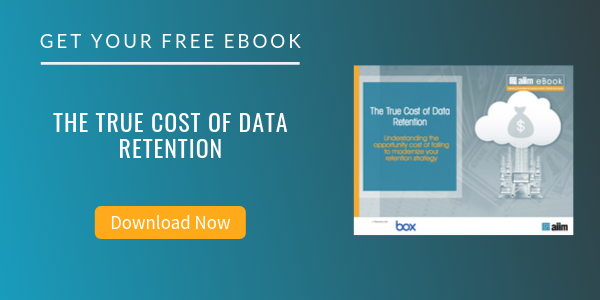
When Pressing Delete Is OK: Learn How to Eliminate ROT in Your Organization
If your organization is like just about every other organization on the planet, you likely have some degree of an information management problem. Most likely, you create too much information, and you keep too much of it for too long.
This causes enough problems by itself, but when you then add to the pile all the redundant, obsolete, and trivial (ROT) information you have in your systems, on your file shares, and in every other possible location, it’s a real nightmare. And it’s expensive – in terms of storage costs, in time to find information, in resources, and, sometimes, in fines and legal penalties.
The prospect of cleaning up your digital landfill can be daunting. It’s like doing spring cleaning: you know it needs to be done.
But luckily, there are some strategies that can help. And just like with spring cleaning, you’ll feel so much better and be so much more productive once it’s done.
Don’t Let Your Information ROT
- Don’t Collect It: As I’ve written in other contexts, the first step to dealing with ROT effectively is not to collect it in the first place. While every organization needs to create and use information to support business processes, the key is not to let that information ROT. Rather, it should be kept while it has a business or legal value, and then disposed of; we’ll talk more about that shortly.
- Use a Repository: Having a centralized repository can definitely help cut down on redundant copies of information. Users shouldn’t need to save and maintain their own copies if they can find what they need in the repository. This also cuts down on the number of outdated versions floating around. Similarly, users should be encouraged to send links instead of attachments. This cuts down on copies AND versions – and actually improves information security by adding a layer of login requirement in order to access the linked document.
- Put Policies in Place: Specifically, develop policies that encourage users to send links and keep things in the appropriate repository. These will help to reduce the redundant and outdated information. And develop policies around personal or non-business usage of organizational networks to cut down on the trivial.
Identifying and Evaluating ROT
The other side of the equation is to get rid of information when it no longer has any business or legal value. We put together this tip sheet in the context of file share cleanups and how you can determine whether information is still of value.
At the same time, though, it’s important to recognize two issues with getting rid of information.
- Users Don’t Want to Do It: Sometimes this is because they feel they may need it for some reason in the future – aka “just in case.” It’s also sometimes easier to keep things than get rid of them – that’s why most break room refrigerators look like they are filled with science experiments!
- Just Because Something is Older or Hasn’t Been Accessed in Some Time Does Not Mean it No Longer Has Business Value: Sometimes records have very long or even permanent retention periods. Information might be on hold as part of a legal or regulatory inquiry. This means that before starting any comprehensive cleanup initiative, at least for information that did have business value at one point, it’s important to get records management, legal, risk, compliance, whoever it is that owns those functions involved.
When Pressing Delete is OK
Once you’ve determined that it is, in fact, OK to press the delete button for some types of information, I recommend that you automate that process to the maximum extent possible. Key ways to automate deletion include:
- Set an Expiration Date: Many systems offer the ability to set an expiration date for content created or added therein. Again, there can be records management concerns here, but this can be a great way to ensure that low-value or fairly short-lived content can be gotten rid of efficiently.
- Set Up Automated Rules: Every IT shop already has an automated process in place to delete executable files from the network because executables offer a significant security risk. But we can leverage this mindset to eliminate non-business-related information too. For example, let’s say at AIIM that I use MP3 files for the online courses (because I do). Let’s further say that no other department at AIIM uses MP3 files for business. This means that I could set up a rule that basically checks the network for MP3 files on a regular basis, and any time they are found anywhere other than my department’s folders, they get deleted automatically. Maybe we set up a rule to email the owner of that location. Maybe we give 3 or 7 or 30 days to move them to where they should be. But ultimately, they get deleted automatically and with little risk to the organization assuming the rules are set up properly.
- Set Up a Bias Towards Disposition: There are two ways to look at disposition: asking permission and asking for forgiveness. Most organizations will ask permission – that is, requiring layer after layer of approval in order to follow the approved records management and disposition programs. A better way is to ask permission – that is, put a process in place where disposition is normal and expected absent a specific need to suspend it. Once this is in place, while the actual disposition acts may be manual or automated, the decision-making process will largely be automated unless there really is a need to suspend disposition for some concrete reason. But this approach does require a lot more trust and information management maturity.
ROT Won't Clean Itself and WILL Get Worse
Cleaning out your redundant, obsolete, and trivial information makes it easier for staff to find information, trust what they find, and take effective action in support of business outcomes. Once you clean out your digital landfill, many of these steps will contribute to keeping your information repositories clean and useful moving forward.
But, without action, information ROT will continue to compound and remain an issue. The sooner you address it using these tips, the sooner you will will relieve storage costs, empower you employees, and speed up your overall business.



